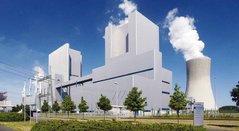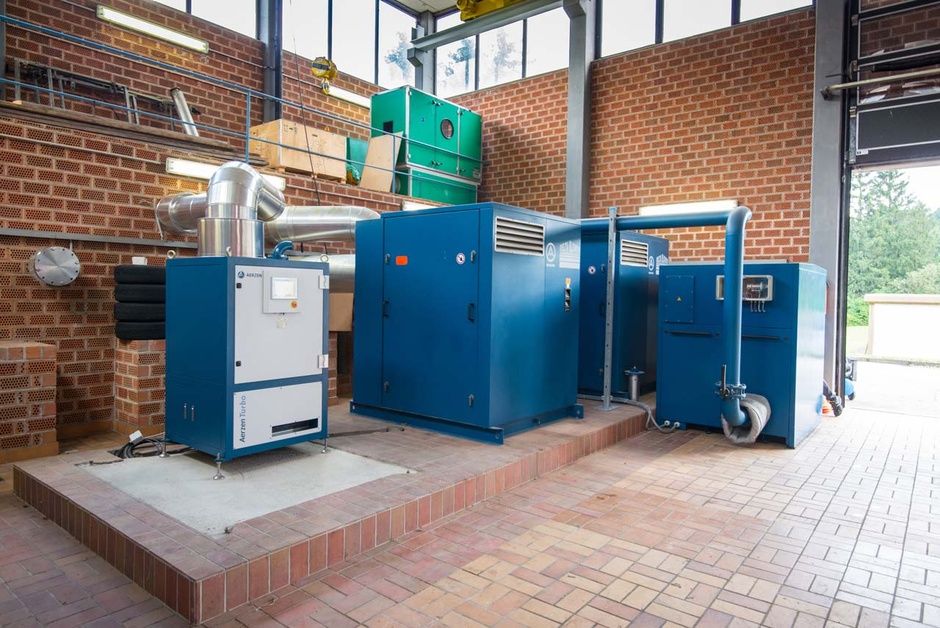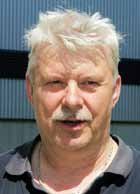Vattenfall-Braunkohlenkraftwerk
Modern extraction systems in the lignite-fired power plant of Vattenfall
The ultra-modern power plant in Boxberg generates electricity and heat and is the second largest plant of the Swedish energy group Vattenfall in Germany which is powered by lignite. Although all conveying units in the coal charging operation have been provided with dedusting systems, coal dust deposits cannot be avoided entirely due to the length of the belts, the high conveying speed and the considerable transportation volume up to 1,600 tons of lignite per hour. The Fire Protection Ordinance stipulates that the layer thickness of these deposits may not exceed three millimetres.

Dry cleaning instead of wet cleaning
For this reason, all units had been carefully cleaned with water on a regular basis until 1990, when cleaning was switched over to dry cleaning. Special independent piping systems to remove the coal dust have been fitted. Mobile dust suction systems supply the necessary negative pressure. Meanwhile, four explosion-proof versions are in use on the premises. The manufacturer, IB Verfahrens- und Anlagentechnik GmbH & Co. KG in Lage, had constructed all of them as road vehicle units, because road traffic regulations must be observed on the premises. The vehicles had been continuously improved over the years with the result that the latest unit operates with only one knock-out vessel. “Since the very beginning of the co-operation with Vattenfall in Boxberg we have been using Delta Blower of Aerzener Maschinenfabrik,” said Dipl.-Ing. Harry Lippmann, Project Manager at IB Verfahrens- und Anlagentechnik, adding : “Aerzen offers reliable packaged units and excellent service”
Aerzen PositiveDisplacement Blower
The units used in Boxberg operate with constant speed and negative pressure of 500 mbar. The new Aerzen unit is started manually via the operating panel. The blower, with a motor rating of 55 kW, is provided with a soft start. The dusty air, which is sucked in, first enters an explosion-proof separation tank via an explosion-proof slide where the coal dust element falls out. A second explosion-proof slide is installed behind the tank. In case the pressure increases unavoidably in the separation tank, both will be closed immediately via an explosion-proof pressure detector which is permanently monitored, so that a flame, should one arise, cannot enter the intake and the discharge pipes.
The precleaned air then reaches a zone separation filter. After this, the cleaned air enters the Aerzen blower which is installed in a sound-absorbing housing and then it is discharged into the atmosphere with a dust content of less than 0.01 mg/m3. It is not necessary for these blowers to be explosion-proof as the moveable dust extraction units are only operated outside the building, and for this reason they are not liable to explosion risk.
The units used in Boxberg operate with constant speed and negative pressure of 500 mbar. The new Aerzen unit is started manually via the operating panel. The blower, with a motor rating of 55 kW, is provided with a soft start. The dusty air, which is sucked in, first enters an explosion-proof separation tank via an explosion-proof slide where the coal dust
element falls out. A second explosion- proof slide is installed behind the tank. In case the pressure increases unavoidably in the separation tank, both will be closed immediately via an explosion-proof pressure detector which is permanently monitored, so that a flame, should one arise, cannot enter the intake and the discharge pipes.The precleaned air then reaches a zone separation filter. After this, the cleaned air enters the Aerzen blower which is installed in a sound-absorbing housing and then it is discharged into the atmosphere with a dust content of less than 0.01 mg/m3. It is not necessary for these blowers to be explosion-proof as the moveable dust extraction units are only operated outside the building, and for this reason they are not liable to explosion risk.


Waldemar Adomßent, Vattenfall, lignite-fired power plant Boxberg:
»The vehicles supplied by IB Verfahrens- und Anlagentechnik and provided with Aerzen positive displacement blowers are in use in two shifts from Monday to Friday. We appreciate the easy operation of the units and their high inlet flow with which it is possible to take coal pieces even the size of a lump of sugar«
Practical and efficient
Dust, which accumulates inside the separator in the filter, is discharged via a pneumatic filter dedusting. A small piston compressor in the blower housing supplies the necessary compressed air. It also provides the isolation valves and arranges for the loosening up of the coal dust, that has reached the tank, by the temporary filling of air cushions. The tank volume is thus ideally used. When the maximum filling level is reached, a level probe stops the suction process so that the tank can be emptied via an electrically operated flap on the ground, and the charged coal dust can be sent to the bunker complex again.